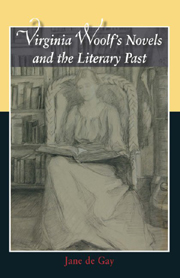Book contents
- Frontmatter
- Contents
- Acknowledgements
- Abbreviations
- Introduction
- 1 From Woman Reader to Woman Writer: The Voyage Out
- 2 Tradition and Exploration in Night and Day
- 3 Literature and Survival: Jacob's Room and Mrs Dalloway
- 4 To the Lighthouse and the Ghost of Leslie Stephen
- 5 Rewriting Literary History in Orlando
- 6 ‘Lives Together’: Literary and Spiritual Autobiographies in The Waves
- 7 Bringing the Literary Past to Life in Between the Acts
- Conclusion
- Select Bibliography
- Index
1 - From Woman Reader to Woman Writer: The Voyage Out
Published online by Cambridge University Press: 12 September 2012
- Frontmatter
- Contents
- Acknowledgements
- Abbreviations
- Introduction
- 1 From Woman Reader to Woman Writer: The Voyage Out
- 2 Tradition and Exploration in Night and Day
- 3 Literature and Survival: Jacob's Room and Mrs Dalloway
- 4 To the Lighthouse and the Ghost of Leslie Stephen
- 5 Rewriting Literary History in Orlando
- 6 ‘Lives Together’: Literary and Spiritual Autobiographies in The Waves
- 7 Bringing the Literary Past to Life in Between the Acts
- Conclusion
- Select Bibliography
- Index
Summary
The year after The Voyage Out was published, Woolf wrote in ‘Hours in a Library’ that ‘the great season for reading is the season between the ages of eighteen and twenty-four’ (CE, II. 34). In her own case, that six-year period led up to her beginning Melymbrosia, the first draft of The Voyage Out, in 1907, at the age of twenty-five (L, I. 315 n.; QB, I. 125). Quentin Bell suggests that Melymbrosia ‘may have had its beginnings in Virginia's imagination’ in 1904 (QB, I. 125) and indeed, Woolf herself suggested that she had a ‘vision’ of her first book whilst visiting Manorbier in March 1904, which means that the novel was conceived in the midst of this period of intensive reading. In ‘Hours in a Library’, Woolf notes that ‘scarcely any of the contemporary writers’ are among the authors she read during that time, except George Meredith, Thomas Hardy and Henry James, who (she argues) had classic status, although they were still alive (CE, II. 36). This insight into Woolf's reading habits suggests that she began her own writing career by immersing herself in the work of others – almost exclusively writers from past eras. The process of writing The Voyage Out can thus be seen as a period of transition from reading books by earlier authors to writing her own. Woolf's reading of past literature and her reflections on the nature of reading had significant effects on the novel.
- Type
- Chapter
- Information
- Virginia Woolf's Novels and the Literary Past , pp. 19 - 43Publisher: Edinburgh University PressPrint publication year: 2006



